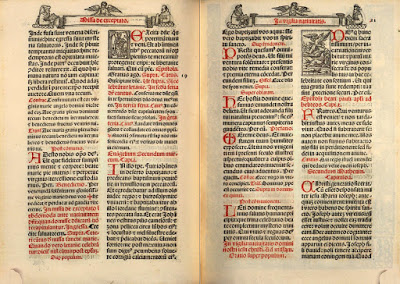| Online: | |
| Visits: | |
| Stories: |

| Story Views | |
| Now: | |
| Last Hour: | |
| Last 24 Hours: | |
| Total: | |
Ambrosian Prefaces for Advent – Part 2
For the feast of St Ambrose, we continue our series on the Ambrosian Prefaces of Advent. Click here to read the first part.
Here then are the prefaces of the Fourth and Fifth Sundays of Advent, and of the proper Mass of the ferias “de Exceptato”. The opening formula is the same that of as the Roman Rite, except that the word “quia” is added after “Vere”. In manuscript sacramentaries and missals, this formula was usually abbreviated to a highly stylized V and D joined together, a custom which carried over into some early printed editions; I have used it below from a printed Ambrosian Missal of 1522. The conclusion varies, as it does in the Roman Rite, and the formula “Per quem majestatem tuam” is longer, including the names of all nine choirs of Angels. (See the previous post in this series.) The other most common formula “Et ideo…” is the same as in the Roman Rite.
Cui proprium est veniam delictis impéndere, quam poenáliter imminére. Qui fábricam tui óperis per eundem rursus lápidem es dignátus erígere, ne imágo, quae ad similitúdinem tui facta fúerat vivens, dissímilis haberétur ex morte. Munus veniábilis indulgentiae praestitisti: ut unde mortem peccátum contráxeret, inde vitam píetas reparáret immensa. Per Christum.
Truly…Almighty God: To whom it is proper to generously grant the forgiveness of sins, rather than threaten with punishment. Who deigned to raise up again through the same stone what Thy work had built, lest the living image which had been made in Thy likeness, should by death become unlike Thee. Thou didst grant the gift of pardon and forgiveness, that Thy boundless mercy might restore life, where sin had brought in death. Through the same Christ our Lord. Through whom the Angels praise Thy majesty etc.
Per Christum, Dóminum nostrum. Cuius divínae nativitátis potentiam ingénita virtútis tuae génuit magnitúdo. Quem semper Filium et ante témpora aeterna generátum, quia tibi pleno atque perfecto aeterni Patris nomen non défuit, praedicámus. Verum etiam honóre, maiestáte, atque virtúte aequálem tibi cum Sancto Spíritu confitémur, dum in tribus persónis únicam crédimus maiestátem. Quam laudant Angeli Per quem.
Truly…Through Christ our Lord. The unbegotten greatness of Thy might begot the power of His divine nativity, Whom we proclaim was ever the Son, and unbegotten before all time; for Thy name of eternal Father has ever been fully and perfectly Thine. But we also confess Him equal to Thee in honor, majesty and might, as we believe that in three Persons there is but one majesty. Which the Angels praise etc.
Et maiestátem tuam humíliter expóscere: ut ita nos Unigéniti tui in praesenti sáeculo illustret respectus, quáliter culpis ómnibus emundátos inveniat secundus eius adventus. Per quem….
Truly…Through Christ our Lord, whose coming we await. Truly…eternal God, and humbly to beseech Thy majesty, that in this present age, Thy only-begotten Son may so enlighten us with His countenance, that when He comes again, He may find us cleansed of every fault. Through Whom the Angels praise etc. etc.
Source: http://www.newliturgicalmovement.org/2015/12/ambrosian-prefaces-for-advent-part-2.html






